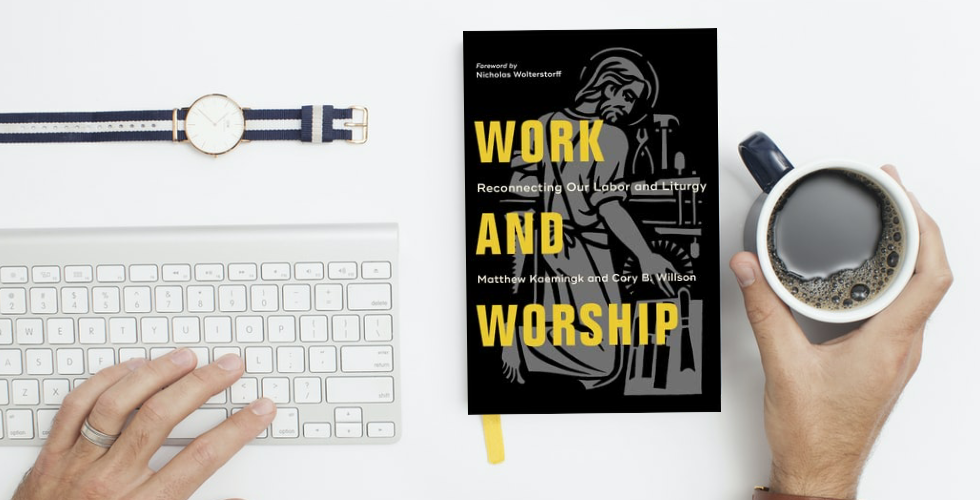
In Work and Worship: Reconnecting Our Labor and Liturgy, authors Matthew Kaemingk and Cory B. Willson set out to reform the Christian view of our daily labor and Sunday morning worship. Their book is primarily aimed at church officers, and particularly pastors. The problem presented is in the view of the average Christian today. By and large, Christians don’t understand how the activity of Sunday worship relates to the daily hustle and grind of their work. There is a distinct separation of church from business. Kaemingk and Willson argue that “gathered worship can be a (trans)formational space for workers and their work,” and that pastors are positioned by their ordination, to facilitate our understanding of the relationship between our worship of God and service to others.
The book is laid out in three parts: Foundations, Resources, and Practices. In part 1, Foundations, the authors ask if Sunday worship is more than mere religious ritual – a rote performance of “going through the motions?” Or, is our worship a real, life-giving, soul-renewing, rest-receiving gathering between God, the Divine Creator and life-sustainer of the entire cosmos, and us, his image bearers who mimic this creativity in our everyday lives? In Part 2, Resources, they present the historical and biblical-theological foundation connecting our work (vocation-calling) to worship. Finally, in part 3, Practices, the authors provide practical ideas and suggestions for incorporating and/or adapting the liturgy of worship to concretize the value of vocation in the life of workers.
Doug Stuart and Kerry Baldwin interviewed Matthew Kaemingk on the LCI Podcast for this book.
The authors write from a Dutch Reformed perspective. The Dutch Reformed tradition is branched into more or less historically orthodox subcategories. However, Kaemingk and Willson attempt to address a broad audience regardless of tradition. Ecumenical works are often very difficult to get right. There is so much that could be misinterpreted or dismissed. As a contributor at LCI, I can relate to the difficulty in trying to advocate for doctrinal distinctives on a platform that is wide-reaching and ecumenical. This is no easy task and it’s the task Kaemingk and Wilson set out for themselves.
Kaemingk and Wilson make a persuasive case that churches have (over time) lost sight of the importance of vocation. Christians are often told on Sundays to leave the stress of life “at the door” of the church. We put on our “Sunday best” including our rehearsed smiles and artificial niceties. “This is our day of rest, so don’t stress us out with your troubles at work. No one wants to hear that. We’re here to worship God!”
Some readers may find this section more or less palatable depending on how you view vocation in the life of the Christian. Some denominations are better at this than others. Lutherans, for example, have a high view of vocation as does the Dutch Reformed. Others, perhaps, not so much. “Vocation” is reduced to societal “roles.” Perhaps unwittingly, this small view of vocation in Christian life contributes to damage brought by individual stress. That stress, in turn, affects the body of believers. But pretending the effects of work doesn’t bother us is not a solution.
The authors even make an effort to incorporate a trauma-informed perspective, something that is greatly lacking in our congregations:
“… church leaders need to reckon with the glaring fact that these people are not just worshippers; they’re also workers. As such, their work experiences, their vocational joys, sorrows, stresses, and successes are carried in their bodies every time they enter the sanctuary, sometimes consciously and sometimes totally unawares. Footnote: ‘…stressful experiences (trauma) leave imprints on the human mind, emotions, and body. Such stressors are inscribed in workers and cannot be simply reasoned away through disciplined thinking, or talk therapy. Some form of embodied activity or ritual is needed in the healing process’. (Bessel A. van der Kolk, The Body Keeps the Score.)”
This section isn’t meant to condemn those churches that have lost sight of vocation. Instead, this book is intended to build them up and not merely from an emotional perspective. In our interview, Kaemingk emphasized this book is not ultimately about making people “feel good” about their work. Instead, its meant to connect the meaning of our creative work to our worship of God, our divine Creator.
This book is a theological, philosophical, and practical work. The message for pastors is to not feel condemned if you haven’t understood the connection between vocation and worship. Instead, pastors may be inspired to change to fulfill their calling as undershepherds called to feed Christ’s sheep.
Part two encompasses a great deal of theological arguments (from Scripture) and philosophical arguments (from early Christian texts). Though the ancient Israelites and early church had no theology of work (vocation) per se, work (vocation) was so integral to the believer’s life that it always showed up in worship.
Kaemingk and Willson provide surveys of the Pentateuch, the Psalms, the Prophets, and the Early Church to demonstrate both the theological and philosophical points. Not only do we give thanks and praise to God for his various provisions, but we are also taught by Scripture how to incorporate lamentations of struggles, hardships, pain, and anguish. The practice of Biblical lament has been mostly lost in broader evangelicalism today where nearly any lament is seen as complaint, discontent, and even arrogance or pride. As a result, many Christians have suppressed their expressions of negative emotions before God which contributes a great deal to the traumatic imprints mentioned earlier.
Kaemingk and Wilson want a reformation that more fully realizes the range of vocational callings and all that goes with that in order that we might better receive the gifts God bestows to us both in public (corporate) worship, and in our private worship.
This section might be seen as the most controversial for potentially two reasons. First, the authors propose modernized prayers, blessings, ritual practices, and benedictions into the liturgy of public worship. Second, some of the proposed wording of these things might give the reader the impression the authors have a particular political-economic bent.
During our interview, Kaemingk, emphasized these were merely suggestions for those pastors and church leaders who have gone without a more robust doctrine of worship. It is not intended to re-imagine or re-invent liturgies that draw from Scripture and ancient practice. If anything, Kaemingk and Willson are themselves drawing from ancient practice and liturgies. They don’t wish to be luddites against modernization per se. However, much of the worship seen in churches today have neglected the ancient practices in their attempts to be relevant to modern culture.
The main thrust of this section is that we gather then scatter. We Christians (as image bearers with a vocational-calling) gather for worship to bring both the fruits of our labor and our laments of our struggles before the Lord. In doing so, the soul-rejuvenating and life-giving gifts of Word and Sacrament give workers a deeper meaningfulness to our temporal lives as we await the coming Kingdom. We are then equipped to go back out into the world (scatter) to share with others our witness of the Gospel and God’s redeeming work in our own lives.
This book is not a statement or argument on proper economic theory. Libertarians reading this book might get that impression from time to time. Kaemingk’s interview is helpful in understanding what this book is not about – economic theory. Instead it’s an effort to equip pastors to convey to their congregations the connection between the daily grind of our vocation-callings, and how that cultivates the coming Kingdom of God. In this case, Christian libertarians can find common ground in our own laments about what distorts, corrupts, and interferes with the spontaneous order of the market.
There is something to be said about Evangelicalism’s disconnect between vocation and worship. If becoming Christian changes you, and you interact in the world, then doesn’t our regeneration impact the world? And if we can impact the world, can we not influence and even change the world? Some Christians are uneasy with these questions. Kaemingk and Willson want to persuade you that not only does our work matter, but it matters as regenerate believers awaiting Christ’s return and the coming Kingdom of God.
If you haven’t seen the connection between work and worship, Kaemingk and Willson aren’t here to beat you over the head and make you feel bad about that. They are inviting you into a facet of the Christian life that is both exciting and a relief for the weary. They show you that Matthew 11:28-30 is not just for the spiritually weary, but the physically, emotionally, and vocationally weary as well. God is our rest and rejuvenation as we sojourn this temporary existence.
“Come to me, all of you who are weary and burdened, and I will give you rest.
Take up my yoke and learn from me, because I am lowly and humble in heart,
and you will find rest for your souls. For my yoke is easy and my burden is light.”
Matthew 11:28-30

Articles posted on LCI represent a broad range of views from authors who identify as both Christian and libertarian. Of course, not everyone will agree with every article, and not every article represents an official position from LCI. Please direct any inquiries regarding the specifics of the article to the author.
Did you read this in a non-English version? We would be grateful for your feedback on our auto-translation software.
), //libertarianchristians.com/wp-content/plugins/smartquizbuilder/includes/images/template6-latest.jpeg))

), https://libertarianchristians.com/wp-content/plugins/smartquizbuilder/includes/images/template6-latest.jpeg))








































), https://libertarianchristians.com/wp-content/plugins/smartquizbuilder/includes/images/template6-latest.jpeg))
), https://libertarianchristians.com/wp-content/plugins/smartquizbuilder/includes/images/template6-latest.jpeg))
), https://libertarianchristians.com/wp-content/plugins/smartquizbuilder/includes/images/template6-latest.jpeg))





*by signing up, you also agree to get weekly updates to our newsletter
Sign up and receive updates any day we publish a new article or podcast episode!